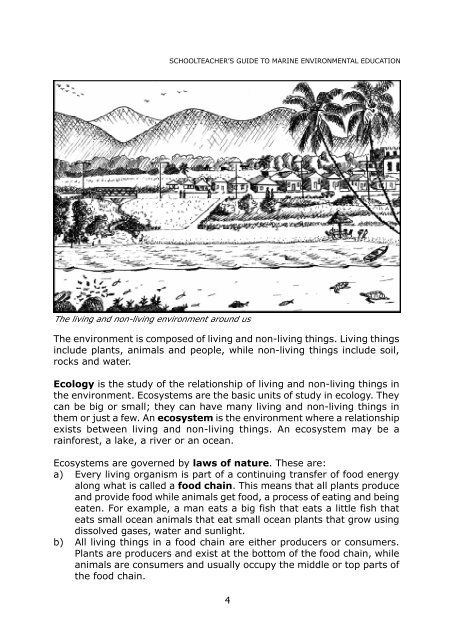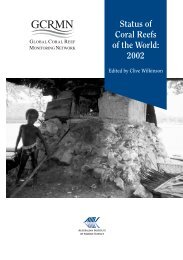A School Teachers Guidebook to Marine Environmental Education ...
A School Teachers Guidebook to Marine Environmental Education ...
A School Teachers Guidebook to Marine Environmental Education ...
Create successful ePaper yourself
Turn your PDF publications into a flip-book with our unique Google optimized e-Paper software.
SCHOOLTEACHER’S GUIDE TO MARINE ENVIRONMENTAL EDUCATION<br />
The living and non-living environment around us<br />
The environment is composed of living and non-living things. Living things<br />
include plants, animals and people, while non-living things include soil,<br />
rocks and water.<br />
Ecology is the study of the relationship of living and non-living things in<br />
the environment. Ecosystems are the basic units of study in ecology. They<br />
can be big or small; they can have many living and non-living things in<br />
them or just a few. An ecosystem is the environment where a relationship<br />
exists between living and non-living things. An ecosystem may be a<br />
rainforest, a lake, a river or an ocean.<br />
Ecosystems are governed by laws of nature. These are:<br />
a) Every living organism is part of a continuing transfer of food energy<br />
along what is called a food chain. This means that all plants produce<br />
and provide food while animals get food, a process of eating and being<br />
eaten. For example, a man eats a big fish that eats a little fish that<br />
eats small ocean animals that eat small ocean plants that grow using<br />
dissolved gases, water and sunlight.<br />
b) All living things in a food chain are either producers or consumers.<br />
Plants are producers and exist at the bot<strong>to</strong>m of the food chain, while<br />
animals are consumers and usually occupy the middle or <strong>to</strong>p parts of<br />
the food chain.<br />
4
















